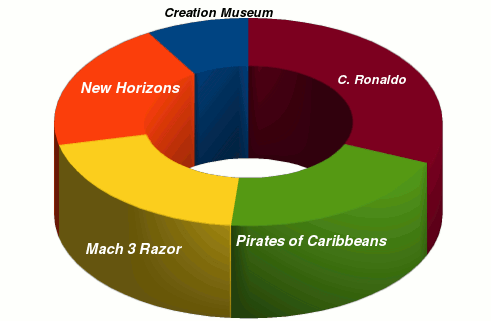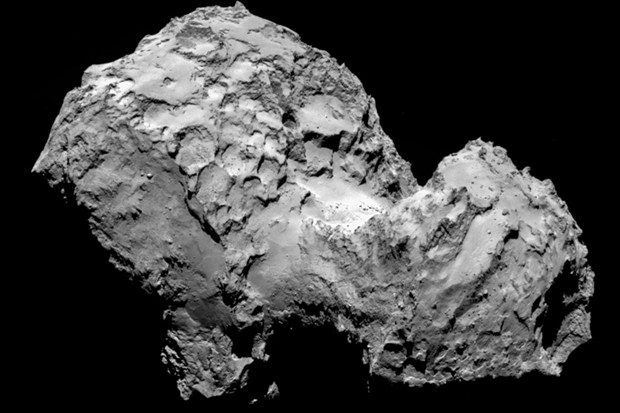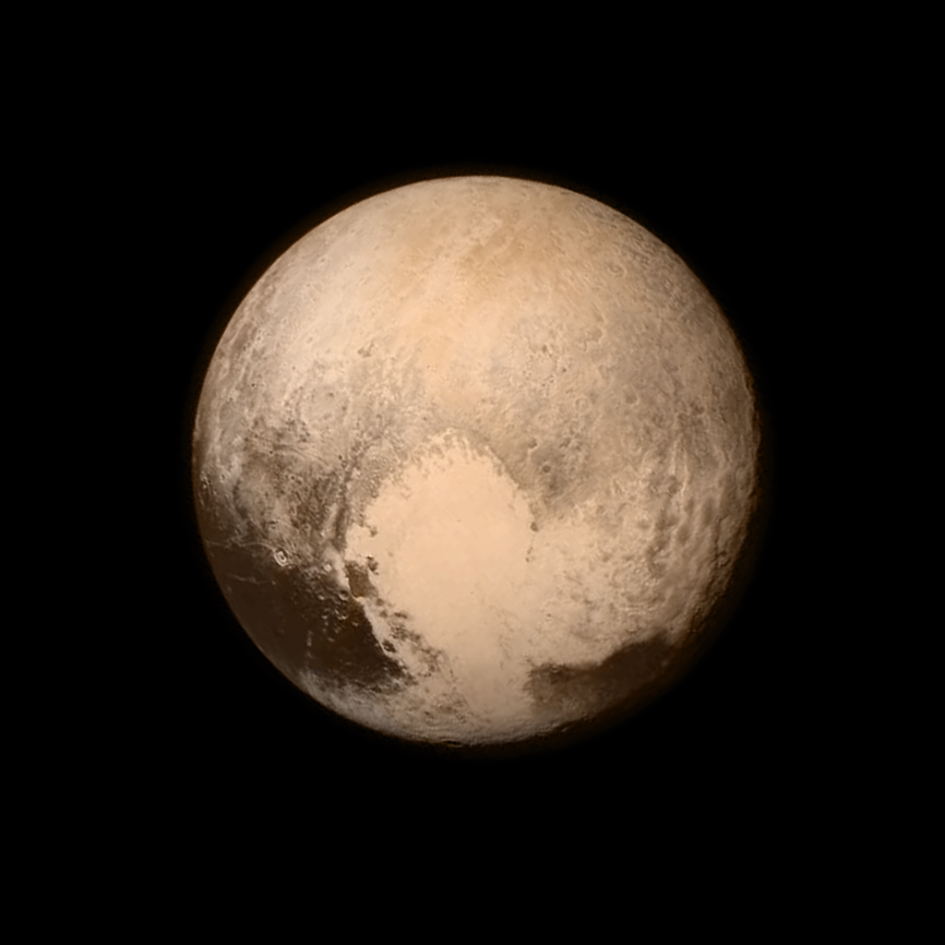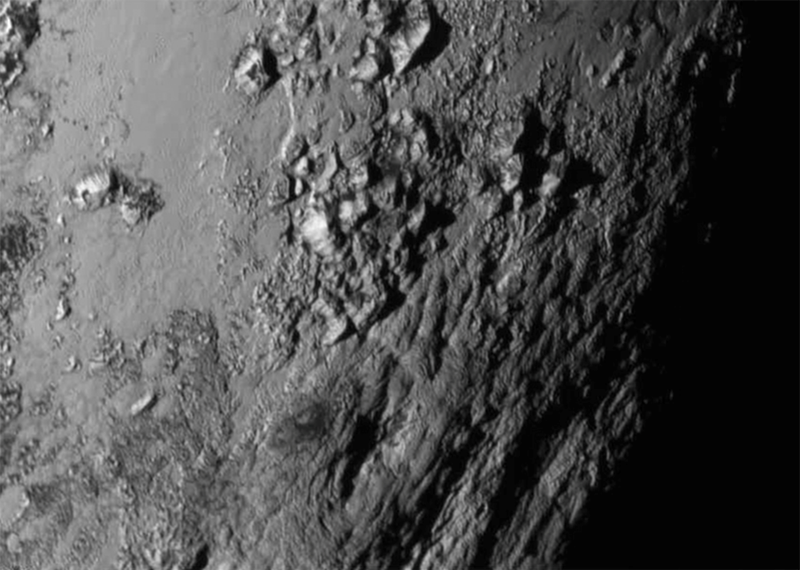After a long journey of 9 years in the solar system, the New Horizons spacecraft has conducted the first in-situ reconnaissance of Pluto. Our solar system is made by rocky planets like the Earth, Mars, Venus and Mercury that populate its inner regions, by gas giants like Jupiter, Saturn, Uranus and Neptune in the outer regions and several smaller icy dwarf planets that populate the regions beyond Neptune’s orbit. Pluto represents the biggest icy dwarf planet known and its surface has remained a big mystery since its discovery in 1930 by US astronomer Clyde W. Tombaugh.
As of today several icy dwarf planets have been discovered but their characteristics are all very poorly known since it is extremely difficult to observe them from Earth given their large distance and small size. Pluto is the biggest (and among the closest) icy dwarf planets known. Pluto is a special planet also because it is a double-planet system together with its (smaller) companion Charon. All icy dwarf planets populate a region of the outer solar system known as Kuiper belt (see image below) which is a thick torus made of minor bodies and dwarf planets among which Pluto-Charon.
Today several thousands objects are known to populate the Kuiper belt and up to several hundred thousands bodies are theorized to be present in this enigmatic region. The importance of the Kuiper belt objects and dwarf planets like Pluto is that they are believed to be the remnants of the so-called “protoplanetary disc” which existed before the formation of the solar system and that contained the material that later aggregated into all planets we know (including the Earth). The objects in the Kuiper belt are a sort of “failed planets” which formed at the very early stages of the solar system. Observing the composition of Pluto, its physical characteristics and the complex structure of the Kuiper belt can therefore shed new light on the formation process of our solar system.
I’ve heard some people (as usual) questioning the usefulness of such missions especially nowadays where financial and economic crises are widespread . Why did we have to spend $700 million (the cost of the New Horizons mission) to achieve such a result? First of all the mission cost is not so high as it might seem. I have prepared a simple chart where I compare the cost of the New Horizons with some other human endeavors which, in my humble opinion, are not as spirit lifting as discovering about Pluto, the Kuiper belt and the origin of our solar system. You can see that the cost of the New Horizons mission is equivalent to the production cost of two movies of the “Pirates of the Caribbeans” series (those with Johnny Depp just to be clear). The same amount of money has been spent by the company Gillette to produce the Mach 3 Razor blades, a truly leap forward for humanity (especially for its most hairy members). The cost of the football player Cristiano Ronaldo is around 1 billion euros and the building of the “Creation Museum” in Kentucky —where people can finally be indoctrinated about the World and the Universe being only 6,000 years old— has costed just a bit over $300 millions. Not shown in the chart is the cost of some very important investment made by former boxer Mike Tyson who had the great idea to build a solid gold bathtub for just over $2 millions.

I’ve also prepared a second chart, which this time compares the cost of the New Horizons (total) with the expenditure (total per year!!!) of a few very important human activities like war, lottery sales, recreational drugs, smoking and even the cost of religion tax exemptions. All things we humans can’t truly live without. You judge who’s flushing money down the toilet here.
 Of course beside the scientific value that I explained above, this mission is also about curiosity and being pioneers, two features that truly define our species. It is about knowledge and exploration of the unknown, it is about our place in the universe. Few months ago we have heard of the spectacular results of the ESA Rosetta mission and the Philae lander, the first man made object to orbit a comet (see picture below) and land on it.
Of course beside the scientific value that I explained above, this mission is also about curiosity and being pioneers, two features that truly define our species. It is about knowledge and exploration of the unknown, it is about our place in the universe. Few months ago we have heard of the spectacular results of the ESA Rosetta mission and the Philae lander, the first man made object to orbit a comet (see picture below) and land on it.

Then we have seen the staggering pictures of the Vesta proto-planet from the NASA Dawn mission. Now let’s enjoy this first exploration of the Pluto-Charon system and the Kuiper belt and let’s get inspired by the truly astonishing beauty of knowledge.
Update: Latest image of Pluto shows water ice mountains of 3,500 m.
References
- Health cost of consumption of tobacco worldwide;
- Research and development costs of Mach 3 razor;
- Global military expenditure;
- Recreational drug market;
- Cost of religious tax exemption;
- Cost of “Creation Museum”, a creationist museum in Kentucky;
- Cost of Cristiano Ronaldo, football player of Real Madrid;
- Cost for producing two Hollywood movies “Pirates of the Caribbean: On Stranger Tides” and “Pirates of the Caribbean: At World’s End”;
- Cost of sales of lottery in just the United States;
- Mike Tyson gold bathtub.



July 15, 2015 at 4:02 pm
Reblogged and commented:
Excellent blog by Alessandro Patruno on the New Horizons mission and how the cost of such a mission compares to, for example, lottery sales taxes.